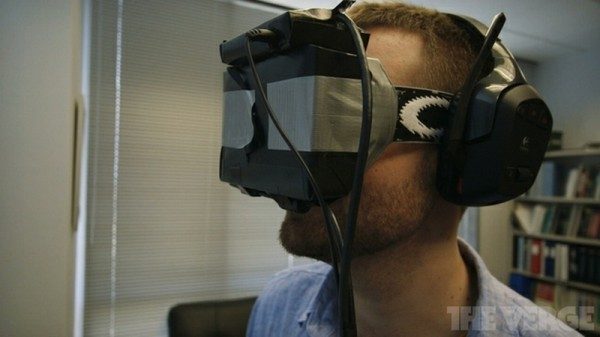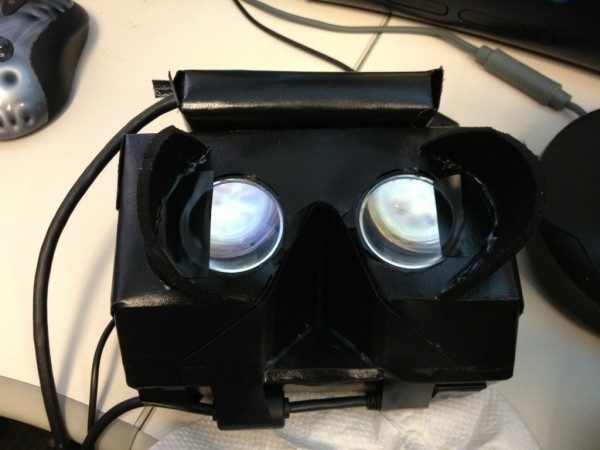 While Sony’s HMZ-T1 and Silicon Micro Display’s ST1080 have made a major splash in the world of head mounted displays by bringing high resolution and (relatively) low cost products to market, a key issue still remains — field of view. Field of View (FoV) describes how much of your vision is taken up by a display. Increasing the FoV means that more of your vision is taken up by the display and this often leads to a much greater sense of immersion. Most of the HMDs available on the market have FoVs of 30 or 45 degress. This isn’t much different than sitting in front of an HDTV that’s across the room. However, over at the MTBS3D forum, user PalmerTech is working on a project to crowd-fund a head mounted display with an impressive (and immersive) 90 degree field of view though Kickstarter.
While Sony’s HMZ-T1 and Silicon Micro Display’s ST1080 have made a major splash in the world of head mounted displays by bringing high resolution and (relatively) low cost products to market, a key issue still remains — field of view. Field of View (FoV) describes how much of your vision is taken up by a display. Increasing the FoV means that more of your vision is taken up by the display and this often leads to a much greater sense of immersion. Most of the HMDs available on the market have FoVs of 30 or 45 degress. This isn’t much different than sitting in front of an HDTV that’s across the room. However, over at the MTBS3D forum, user PalmerTech is working on a project to crowd-fund a head mounted display with an impressive (and immersive) 90 degree field of view though Kickstarter.
The Verge recently took a prototype version of the ‘Oculus Rift’ (as PalmerTech is calling it) for a test drive thanks to John Carmack (of Id fame) who has taken great interest in the project. Mainstream immersive virtual reality gaming is coming, and this might be the first big step.
John Carmack is the founder and technical director of Id Software (responsible for games such as: Wolfenstein, Doom, Quake, Rage). He’s taken great interest in PalmerTech’s Oculus Rift HMD and has been working on a re-release of Doom 3 which he intends to make fully compatible for existing HMDs and high-FoV HMDs like the Oculus Rift.
Ross Miller of The Verge went to Id’s HQ to try Doom 3 BGF on a very early prototype of the Oculus Rift:
Each of your eyes has around a 95 degree FoV (combined together you can see about 180 in front of you). An HMD with an FoV of 45 degrees would take up around 47% of your vision. This is much like sitting with a large HDTV across the room from you. The Oculus Rift has close to a 90 degree FoV which would cover almost 95% of your vision and nearly completely immerse you in the virtual world that you are looking at. While the FoV is great, the Oculus Rift is still a very early prototype and has some issues, the biggest of which is a low resolution. The display is a single 1280×800 panel which devotes half of itself to each eye — making the effective resolution 640×800 — far behind the ST1080’s 1080p displays and the HMZ-T1’s 720p OLED displays.
Carmack has been rigorously testing the Oculus Rift and mentions that, “After dialing everything in, this is by far the most immersive HMD of the five I have here. If Palmer comes close to his price target, it will also be the cheapest. I will be including full support for this in the next new PC title we release [he’s talking about Doom 3 BFG, now announced].”
This is great to hear, but of course the Oculus Rift is nothing but a prototype at this point:

PalmerTech said back in April that he hopped to open a Kickstarter campaign starting on June 1st (tomorrow!) to fund the Oculus Rift’s production. I’m not sure whether or not it will still go live tomorrow but you can be sure that I’ll let you know if it does. Update: Palmer Luckey (AKA PalmerTech) says that the current target date for the Kickstarter is June 14th. More info here.
By all accounts it seems as though the Oculus Rift is targeted toward hobbyists rather than mainstream consumers. PalmerTech notes that, “The display module is going to be detachable from the optics module, so you will be able to modify, replace, or upgrade your lenses in the future!” which is awesome, but obviously a bit beyond the scope of mainstream. Still, with the interest of Carmack who is now showing off the immersion that a high FoV HMD can create, this could be an important step toward seeing mainstream immersive virtual reality gaming. PalmerTech also says that he hopes to produce one version of the Oculus Rift with head tracking and one without.
As brantlew on the MTBS3D forum noted, “We’re hitting a wall of diminishing returns with graphical fidelity. Immersive gaming is the next big leap and all the necessary technology is coming together at this very moment”. I couldn’t agree more, and that’s exactly why I started this blog; all the pieces are here, we just need to bring them together. PalmerTech, Carmack, and friends, might just be intrepid enough to make it a (virtual) reality.







Pingback: E3: The Tech « Triple Vertex()
Pingback: How Sci-Fi becomes Reality – Part 2 – Urban Times()
Pingback: Quora()
Pingback: Nerd Bytes | My Top 3 Anticipated Techs of 2012 | Part 1 | Nerd Bytes()
Pingback: John D. Carmack Backing Developer of $500 Virtual Reality Gamer Headests -()
Pingback: CES 2014 in Las Vegas: Road To VR Will Be There! Let Us Know If You Will Be Too. - Road to Virtual Reality()